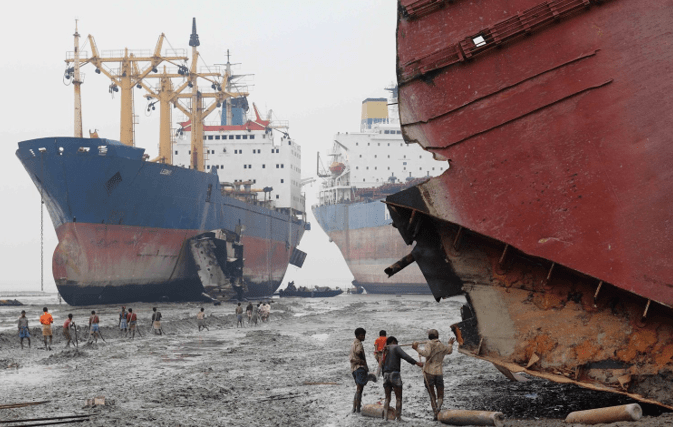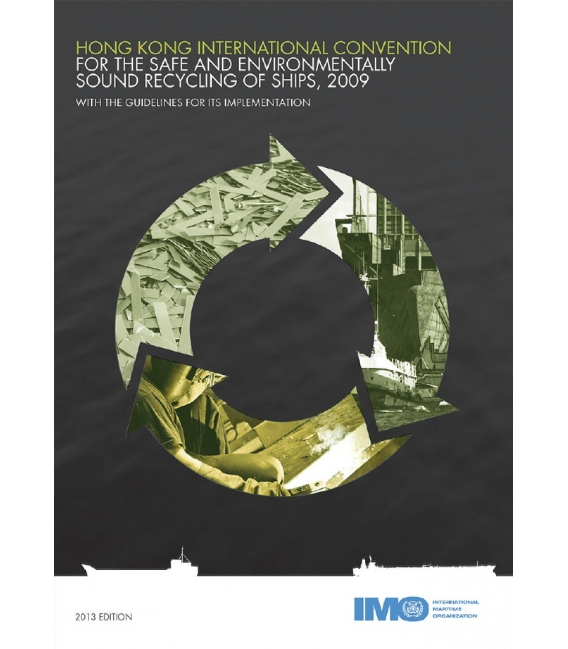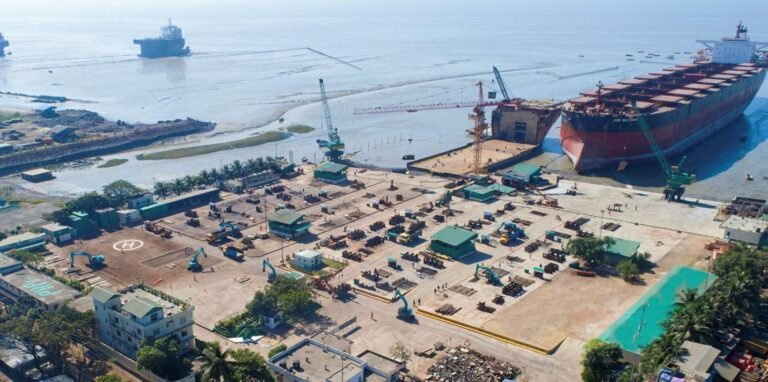Ship Breaking or Recycling – How Much do We Know?
Shaumik Sharif Dipto-
Over the years, people have known shipbreaking to be the dismantling of an entire ship once it reaches the end of its operational period. What the world has perceived as shipbreaking has been simply stated as some selected beaches across the world where ships are brought to their graveyards. But what the world has recently realized is how impactful shipbreaking might be when there has been just one simple modification to the terminology, i.e., recycling of ships in contrast to breaking.
Recycling is a term that indicates how used-up physical materials may be re-processed into usable materials for reuse in any form or shape. A ship is a large element consisting of tons of steel and other non-ferrous materials. After some 15-20 years or even more of a voyage period, a ship loses its excellence in terms of monetary valuation and the operating costs become higher than the turnovers for such old ships. It is this phase when the ship owner decides to sell off the ship to a definite party in exchange for some handsome financial leverage. Thus, obsolete ships reach their end-of-life (EOL) stage and end up landing at any beach or drydock across destinations like India, Bangladesh, Pakistan, China, Turkey, etc.

The process of dismantling or splitting up a large obsolete ship for further recovery and reuse of ferrous and non-ferrous materials, electrical machinery, outfitting, wooden items, and other elements like residual oil and paints, etc. is termed ship recycling.
The process of ship recycling is quite heavy as it involves capitalizing equipment and machinery for scrapping up a ship with the involvement of significant human labor. Developed and highly mechanized nations that used to recycle ships back in the 1960s have slowly stopped this activity owing to increased labor costs and strict industrial occupational safety regulations and thus from the 1980s, gradually this industry shifted to South Asia and some other developing nations. As workplace safety standards are meager and heavy labor can be exploited into cheap labor, these nations have brought many ships for recycling across their beaches over the past three decades.
Certain workplace injuries and incidents significantly drew the attention of international governing bodies and the International Maritime Organization (IMO) which has resulted in amending the existing ship recycling practices across developing nations in South and South-East Asia. After the European Union (EU) legislation and the Basel Convention were put into effect, in 2009, IMO adopted the International Hong Kong Convention (HKC) charter for safe and sustainable ship recycling activity ensuring zero harm to the environment and workplace.
Thus, the concept of compliance in ship recycling was globally recognized by the World and though the ratification of the HKC is yet to be done, many ship recycling facilities across India, Bangladesh, China, and Turkey have already restructured their existing facilities as compliant ship recycling yards under the HKC charter. Hence, the question arises as to what compliance in ship recycling is.

According to the HKC, compliance in ship recycling denotes the availability of pertinent technology, equipment, and facilities that must be secured along with the amenities to train the workforce and safeguard the occupational environment, health, and safety standards at the recycling facility.
Over the past two decades, international bodies and NGOs have vehemently opposed the recycling of ships via intertidal landing or beaching methods and have only complied with the means of ship recycling via drydocking or berthing methods.
For developed nations, drydocking and berthing methods for recycling ships may be viable but for South & South-East Asian nations, from a financial standpoint, intertidal landing or beaching technique of ship recycling seems to be the most affordable option. These countries are going through tremendous economic fluctuation and are not yet stable, hence drydocking or berthing technology would not incentivize these nations in harnessing profitable ship recycling business. Hence, these nations have no option but to comply with safe ship recycling via the beaching method.
Now, is it true that compliance and sustainability in ship recycling can only be achieved by adopting drydocking and berthing methods? – a fact that has been a subject of debate for a long time now amongst NGOs, academicians, and industry experts.
Compliance in ship recycling is related to some extent to the mechanism in which the process is carried out, but it is not arguably the only notion that satisfies the concept of compliance for ship recycling.
India is a remarkable example in this case. A country that stands as one of the top global ship recyclers in the world has accomplished sustainability and compliance in ship recycling via the intertidal landing or beaching method. Currently, around 90 ship recycling facilities in India are acknowledged as green ship recycling facilities and all these yards follow the beaching method for dismantling their ships.
If India can set the bar of compliance in ship recycling through the beaching methods, then definitely compliance holds a greater sample size which should not only be confined to drydocking or berthing methods of ship scrapping.
Likewise, their neighbor, Bangladesh is also progressing fast-forward in working towards ratifying the HKC by 2023. Already, 2 ship recycling facilities in Bangladesh are labeled as compliant ship recycling yards with prospective amenities, equipment, and infrastructure which gives these facilities a strong footing for being acknowledged as green or compliant ship recycling facilities. And some 5 to 7 recycling yards are on the pipeline as well.

Although Pakistan yet has not been able to enable any such ship recycling facility, their government is working towards the goal of HKC ratification, and it is expected that Pakistan’s ship recycling would promote sustainability shortly in the future.
As dictated in the charter of the HKC, the key entities that define compliance and sustainability for ship recycling, in general, are:
-
Concrete or impermeable flooring
-
Oily-water separator area
-
Advanced mechanization like the proper functioning of operational activities via the use of winches, cranes, and excavators
-
Emergency assembly area
-
Well-furnished medical and accommodation facilities, canteens, and lavatories
-
Well-maintained equipment and workshop maintenance
-
High standards of workplace safety with safe and proper use of PPE and health-safety kits and their thorough auditing and maintenance
-
Well-guarded and separated cutting and stacking areas
-
Separately earmarked storage places for incineration and hazardous waste disposal area.
Along with all of these, an inevitably important facility is the availability of a TSDF (Treatment, Storage, and Disposal) facility for the treatment and processing of all sorts of HAZMATS (hazardous materials) drained from obsolete ships.
India and advanced nations with ship recycling facilities already have separate TSDFs but countries like Bangladesh and Pakistan are not yet capacitated with TSDF which poses tremendous health risks to the workforce and vendors engaged with the ship recycling businesses. At present, these HAZMATS are temporarily stored or landfilled and general people along with industry stakeholders are at risk of life-threatening diseases from exposure to these toxic elements.
It may be said that without a TSDF unit, full compliance in the ship recycling economy cannot be achieved. Hence, the local governments and international funding agencies must come up with preventive solutions to develop TSDFs across Bangladesh and Pakistan at the earliest to safeguard the issue of compliance and achieve the prospects of green ship recycling in these countries.
With the world’s population growing rapidly and with the addition of more and more ships in the global maritime fleet, in the upcoming years, huge tons of steel and reusable elements will be recovered from an incredible number of ships that will end up being recycled. This indicates the significance of well-equipped and able ship recycling facilities for scrapping vessels in the future ensuring standard occupational safety practices and compliant technology.
Apart from South Asia, recently South Africa has shown interest in scrapping large vessels. And with the Hong Kong Convention, which is almost on the verge of being globally accepted and ratified by 2023, the competitive ship recycling facilities in the world will have no alternative but to revamp their existing facilities as compliant ship recycling facilities.
It is hoped that globally and across top ship recycling destinations, the importance and outcomes of compliance for the ship recycling industry may be implemented with a promise to protect and preserve the safety of human lives and the environment.
Shaumik Sharif Dipto is a Project Engineer at the Bangladesh University of Engineering and Technology (BUET) in the Ship Recycling Health, Safety & Environment Project



